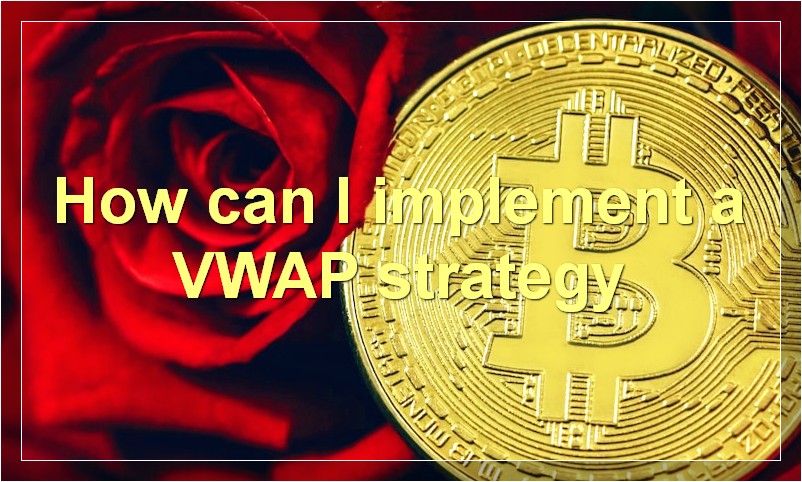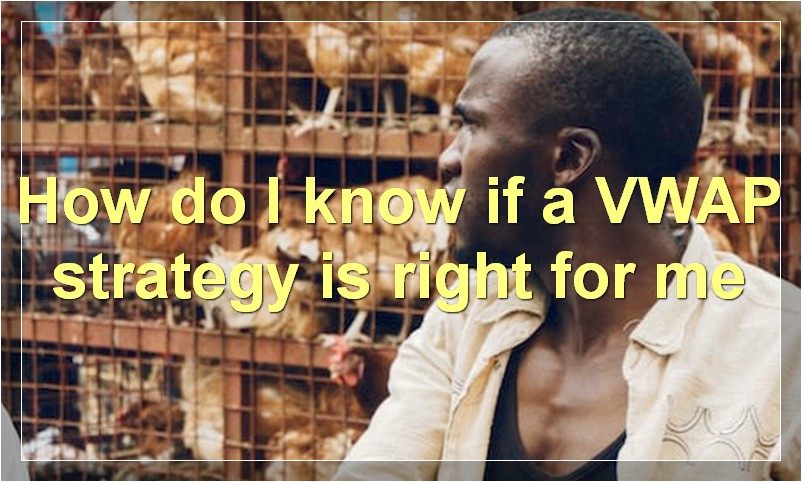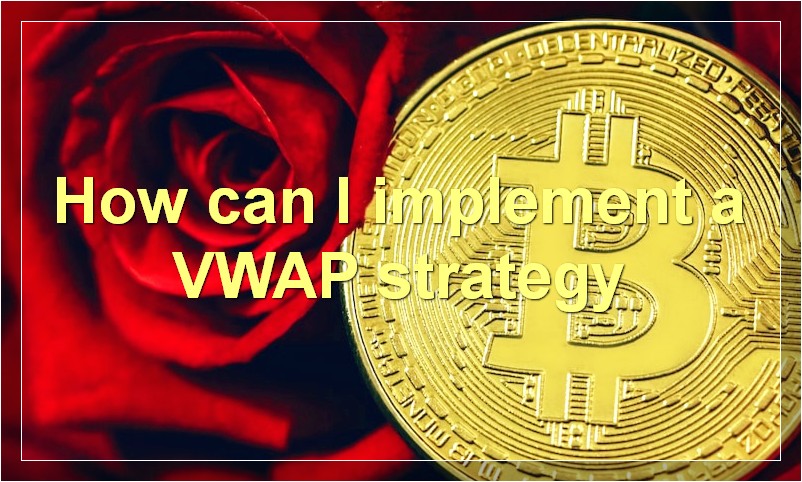If you want to up your trading game, you need to know about VWAP. VWAP, or volume-weighted average price, is a tool that can help you trade more efficiently and effectively.
What is a VWAP strategy
If you’re looking for a successful trading strategy, you may want to consider using a VWAP strategy.
A VWAP, or volume-weighted average price, is a popular trading strategy that many traders use to make decisions about when to buy and sell stocks.
The VWAP is calculated by taking the sum of all traded prices for a stock, divided by the total number of shares traded.
This number gives you the average price of a stock over the course of a day.
The VWAP strategy can be used in two different ways: as a way to enter trades, or as a way to exit trades.
If you’re looking to enter a trade, you would want to buy when the stock price is below the VWAP, and sell when the stock price is above the VWAP.
If you’re looking to exit a trade, you would want to sell when the stock price is below the VWAP, and buy when the stock price is above the VWAP.
The VWAP strategy can be a useful tool for many different types of traders. Day traders often use the VWAP to help them make decisions about when to enter and exit trades. Swing traders and position traders also use the VWAP as a way to gauge whether a stock is overbought or oversold.
If you’re interested in trying out the VWAP strategy, there are many different ways to access it. Many trading platforms have built-in VWAP indicators that you can use. Alternatively, there are also websites that offer free VWAP calculators.
How can I implement a VWAP strategy

When it comes to trading, there are countless strategies that can be employed in order to find success. Some traders focus on technical analysis, while others may prefer to look at the fundamentals of a company. Then there are those who like to use a combination of both approaches. And still others who prefer to trade based on momentum or price action. But no matter what your strategy is, if you’re not implementing a VWAP strategy, you’re missing out on a key tool that can help you improve your results.
So, what is VWAP? Simply put, it is the volume weighted average price of a security over a given period of time. In other words, it takes into account both the price and the volume of a security in order to arrive at a more accurate average price. This is important because it means that VWAP is less susceptible to spikes or dips due to low volume.
There are a number of ways to implement a VWAP strategy. One popular method is to use it as a trailing stop. In this case, you would set your stop loss at the VWAP level and only move it up as the stock price increases. This way, you can protect your profits while still giving the stock room to run.
Another common way to use VWAP is as an entry or exit point. For example, you might wait for the stock price to pull back to the VWAP level before entering a long position. Or, if you were already in a trade, you might exit when the stock price reaches VWAP again. This can help you lock in profits or avoid getting caught in a trend reversal.
There are also some traders who use VWAP as an overlay on their charts. This allows them to see at a glance where the VWAP level is and make decisions accordingly.
No matter how you choose to use it, incorporating VWAP into your trading strategy can help you become a more successful trader. If you’re not already using this helpful tool, consider adding it to your arsenal today.
What are the benefits of using a VWAP strategy
A VWAP strategy can be beneficial for a number of reasons. It can help traders take into account the volume of trades being made, as well as providing them with a reference point for where the market is likely to find support or resistance. Additionally, VWAP can act as a filter, helping traders identify whether a move is due to genuine buying or selling pressure, or simply the result of price fluctuations.
What are the risks associated with a VWAP strategy
A VWAP strategy involves dividing up an order and sending it to the market throughout the day in order to get the best possible price. While this can result in a better price, it also comes with some risks.
The first risk is that the market may move against you while your order is being filled. This could result in you paying more for your shares than you would have if you had just placed the order all at once.
Another risk is that by dividing up your order, you may not get the best possible price for any one trade. This is because the price you get may be different from the VWAP for that time period.
Overall, a VWAP strategy can be a good way to get a better price for your shares, but it does come with some risks that you should be aware of.
What is the difference between a VWAP strategy and other trading strategies
When it comes to trading strategies, there is a wide variety of approaches that traders can take. Some strategies are more aggressive, while others are more passive. Some aim to profit from short-term market moves, while others focus on longer-term trends.
One popular strategy that falls into the latter category is called VWAP, or Volume Weighted Average Price. As its name suggests, this strategy involves taking into account the volume of trading activity when making decisions about where to buy or sell securities.
The VWAP strategy can be used in a number of different ways. Some traders use it as a way to enter or exit positions. Others use it as a tool for managing risk. And still others use it as a way to gauge market sentiment.
No matter how it’s used, the VWAP strategy can be a helpful tool for traders who are looking to take a more systematic approach to their trading.
How do I know if a VWAP strategy is right for me

If you’re considering using a VWAP trading strategy, it’s important to understand how it works and whether it’s right for your trading style.
VWAP, or volume-weighted average price, is a popular trading strategy that seeks to capitalize on the natural order flow of the market. Order flow is the net buying or selling pressure in the market at any given time, and VWAP seeks to take advantage of these imbalances by trading with the prevailing order flow.
There are a few key things to keep in mind when determining if VWAP is right for you:
1. What is your trading style?
Are you a day trader or swing trader? VWAP is most commonly used by day traders, as it’s based on intraday price action. If you’re a swing trader, you may want to consider using another strategy.
2. What time frame are you trading?
VWAP is typically used on shorter time frames, such as 1-minute or 5-minute charts. If you’re looking to trade on longer time frames, such as daily or weekly charts, VWAP may not be the best strategy for you.
3. What markets are you trading?
VWAP works best in markets with high liquidity and tight spreads. If you’re trading in a less liquid market, or one with wide spreads, VWAP may not be as effective.
Keep these things in mind when deciding if VWAP is right for you. If you think it is, start experimenting with it in a demo account to see how it fits into your overall trading strategy.
What are some common mistakes traders make when using a VWAP strategy
When it comes to trading, there is no one-size-fits-all strategy that will guarantee success. However, many traders find success using a VWAP (Volume Weighted Average Price) strategy. This strategy takes into account the volume of trades made in a security and assigns a weight to each trade based on its size. The goal of this strategy is to buy or sell a security at a price that is close to the average price of all trades made during the day.
Despite its potential for success, there are some common mistakes that traders make when using a VWAP strategy. These mistakes can be costly and often result in missed opportunities or losses.
One common mistake is not taking into account the time of day when trading. The VWAP calculation is based on the time of day, so it’s important to consider this when making trades. Many traders make the mistake of only looking at the VWAP for the current day, without considering the time of day. This can lead to missing out on potential trades or making poor decisions.
Another common mistake is not accounting for news events. Major news events can have a big impact on prices, so it’s important to factor this into your VWAP strategy. Many traders overlook news events and don’t take them into consideration when making trades. This can be a costly mistake, as news events can cause prices to move sharply in either direction.
Finally, many traders fail to properly use stop-loss orders when using a VWAP strategy. Stop-loss orders are designed to limit your losses in a trade, but many traders either don’t use them at all or don’t use them properly. This can lead to substantial losses if a trade goes against you.
By avoiding these common mistakes, you can give yourself a better chance of success when using a VWAP strategy. Remember to take into account the time of day, factor in major news events, and use stop-loss orders to protect your capital.
Can I use a VWAP strategy in conjunction with other trading strategies
Yes, you can use a VWAP strategy in conjunction with other trading strategies. For example, you could use a VWAP strategy to help you decide when to enter and exit trades. You could also use a VWAP strategy to help you choose which stocks to trade.
How do I adjust my VWAP strategy as market conditions change
As a trader, it is important to be able to adapt to changing market conditions. One way to do this is by adjusting your VWAP strategy.
VWAP, or the volume-weighted average price, is a popular trading strategy that involves buying or selling based on the average price of a security over a certain period of time.
However, as market conditions change, so too should your VWAP strategy. For example, if there is an increase in volatility, you may want to adjust the timeframe over which you calculate the VWAP. This will help you to better capture the current market conditions.
Similarly, if there is a change in the overall trend of the market, you may want to adjust your VWAP accordingly. For example, if the market is trending higher, you may want to focus on buying at prices below the VWAP.
By being flexible with your VWAP strategy, you can better adapt to changing market conditions and improve your chances of success as a trader.
What resources are available to help me learn more about VWAP strategies
There are a number of resources available to help you learn more about VWAP strategies. These include books, online courses, and articles written by expert traders.
VWAP is a popular trading strategy that is used by many professional traders. If you want to learn more about this strategy, then you should definitely check out some of the resources mentioned above. With the help of these materials, you will be able to quickly learn all there is to know about VWAP strategies and how to use them effectively.

